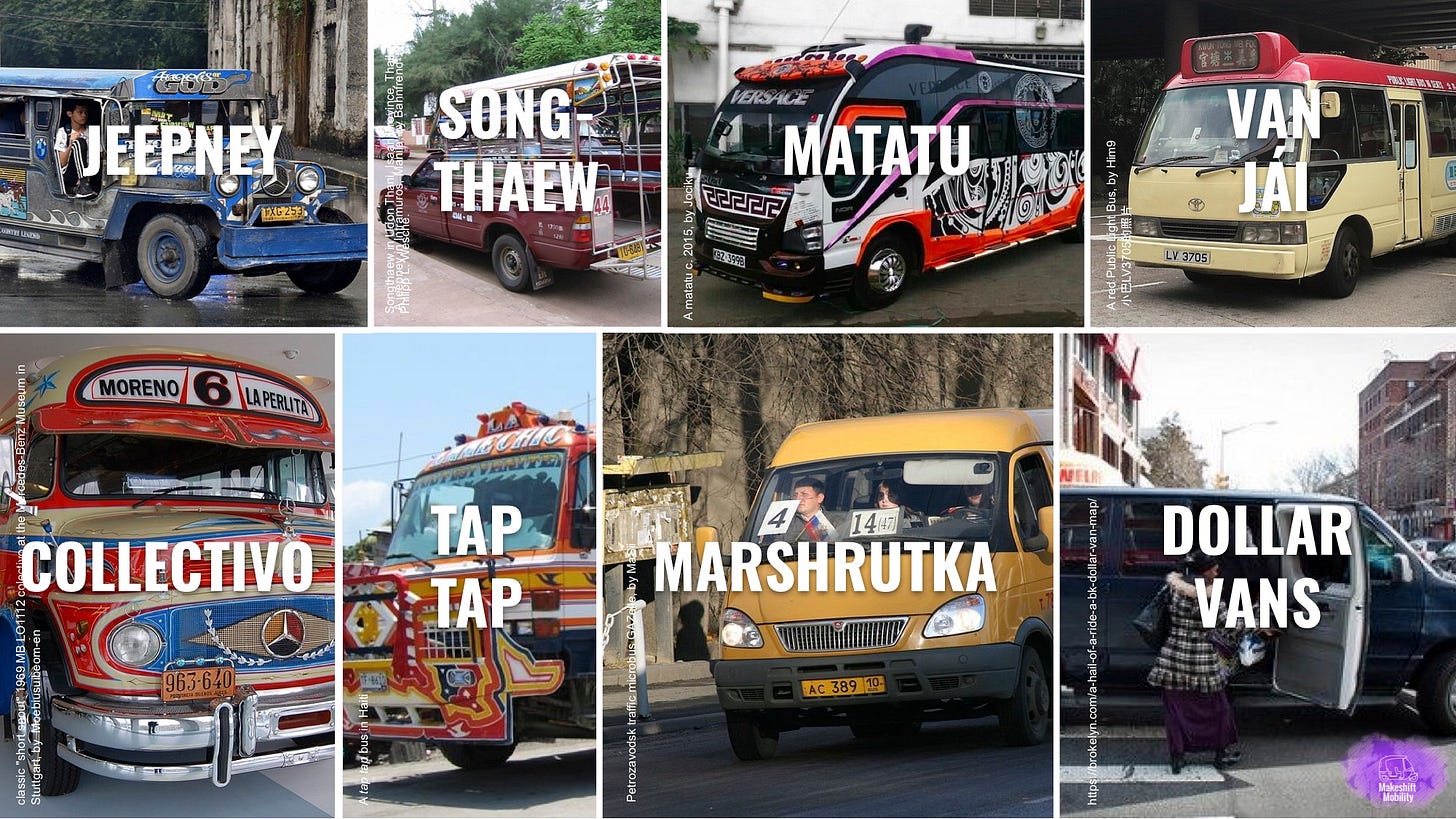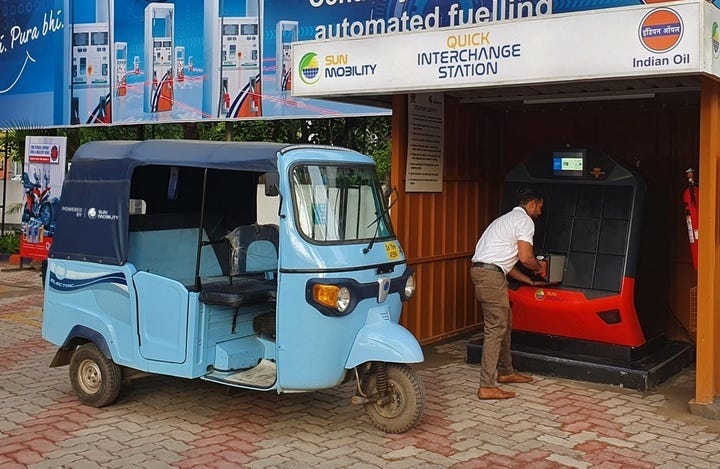#16 No jacket required
But masks. Definitely, masks.
Hey there,
Here’s your biweekly dose of Makeshift Mobility, another email-slash-newsletter-in-your-inbox. I keep you up to date (sort of) on innovations in informal transportation.
If you signed up for this newsletter because you heard my presentation either at Ford Motor Company, Eric Von Hippel’s Innovation Lab at MIT Sloan School, or at the UITP Webinar, welcome!
Thanks for joining.
My personal apologies to you if you were at the UITP forum. We ran overtime and, unfortunately, I couldn’t stay to answer questions.
Feel free to leave a question or just say hello in the comments.
The title of the UITP Webinar was “Key Factors of Success to Formalise Informal Transport and the Significance of Authorities.”
But that got me thinking. Do we really want to formalize informal transportation?
Did you say, “depends on what we mean by formalize”?
Yes. What exactly do we mean when we say formalize. What does success look like?
It may not be what other people mean when they say “formalize” but to me, the word brings images of the top-down imposition of order. Taking all that chaos and wrestling it into submission with strict hierarchies and rigid organization.
I see gantt charts, org charts, and the other wonderful tools of waterfall project management.
I mean, don’t get me wrong. We do need to bring order out of the chaos but the kind of formalization that is imposed from above gets me worried. Will we throw the baby out with the bathwater?
Will top-down approaches lead to the loss of what’s good about the sector?
Will we lose the ubiquity; the responsiveness; the low barriers to entry; the entrepreneurship; the adaptability and resilience; the homegrown vibe; the local identity; the cultural and artistic expression; the social capital and the real world social networks; and yes, the innovation in informal transportation?
I prefer to say we should transform informal transportation.
Or, more to the point, we should enable the transformation of makeshift mobility.
Can we bring order—can we decarbonize, eliminate the precarity, take away the unpredictability, and the hypercompetition?
Can we use a distributed, networked approach to bringing order from the bottom up?
In a word, can we have an agile approach to getting what we want? (Ahem.)
I certainly hope so. Rigid hierarchical organizations are so 20th century, anyway.

Did you know informal transportation is a global phenomena? This is a slide from my presentation. Check out the van jái from Hong Kong; the dollar van from NYC; and, the marshrutka from eastern Europe.
I used to teach English at St. Scholastica’s High School Manila. My students, of course, had to write “formal” essays.
The stuffy old view of formal essays was that it had to be written in third person or had to sound “academic” and “professional.”
I just wanted my kids to learn to write, so to get past the stuffy rules, I just required them to come to class wearing a bow tie on days where we had to write formal essays.
I suspect they learned less with me than in their classes with my more rigid co-faculty members. I am assured, though, that they were more relaxed in my class and they could dial down their teenage cortisol levels for at least one hour.
And some of them turned out to be really excellent writers, too!
Here’s a few things that’s got me excited, picking up from threads we discussed a few issues back.
Electrifying India
India continues to play the right moves in encouraging the electrification of two and three wheelers. Moves that will likely further accelerate the electrification of auto rickshaws.
A month or so ago they announced that these electric vehicles could be sold without the battery and STILL qualify for the incentive discounts under the country’s $1.4B Faster Adoption and Manufacturing of Electric Vehicles (FAME 2) program.

One of Sun Mobility’s battery swapping stations in Chandigarh. Photo from Sun.
The Ministry of Road Transport and Highways said in a statement on Wednesday it has delinked the cost of battery, which accounts for 30-40 percent of vehicle cost, from the EV’s total price tag. This makes the upfront cost of EVs lower than those of internal combustion engine models.
The battery can be provided separately by the original equipment manufacturer or the energy service provider, the ministry said.
According to the Society of Manufacturers of Electric Vehicles (SMEV), a total of 156,000 EVs were sold in the fiscal year ended March 2020, out of which electric two-wheelers accounted for over 97 percent…
India allotted a total of 100 billion rupees for its three-year FAME 2 scheme which started in April 2019, aiming to promote purchases of 500,000 electric three-wheelers, 55,000 electric cars, 7,090 electric buses and one million electric two-wheelers. The plan has already supported purchases of about 15,800 EVs through March 12, 2020, according to the Ministry of Heavy Industries & Public Enterprises.
Did you catch that term, “the energy service provider”-? That’s a nod to the rapidly growing market of battery swapping services from firms like Gogoro and Sun.
They are looking up and down the value chain, too. Amperex, the largest manufacturer of lithium-ion batteries in the world, bought 180 acres outside New Delhi to set up a major manufacturing plant.
(Hat tip to SharedStreet’s Kevin Webb for telling me about the interview with Vivas Kumar on Joe Lowry’s The Global Lithium podcast.)
A report prepared by the U.S.-based Rocky Mountain Institute and national think-tank Niti Aayog said:
If FAME II and other measures are successful, India could realize EV sales penetration of 30% for private cars, 70% for commercial cars, 40% for buses, and 80% for two- and three-wheelers by 2030…achieving these levels of market share by 2030 could generate cumulative savings of 846 million tons of CO2 over the deployed vehicles’ lifetimes.
Meanwhile, in map geek land.
Mapping Minibuses
South Africa based GoMetro has teamed up with UK’s Ascendal to establish urban mobility observatories in ten African cities:
Addis Ababa (Ethiopia)
Blantyre (Malawi)
Dar es Salaam (Tanzania)
Gaborone (Botswana)
Johannesburg (South Africa)
Kigali (Rwanda)
Kinshasa (DR Congo)
Lagos (Nigeria)
Maseru (Lesotho)
Mwanza (Tanzania)
Why is this exciting?
Public agencies typically invest handsomely in large-scale household travel surveys and traffic counts to generate data to support transport plans. Those plans include regional mobility plans and project specific plans for a new metro or BRT, for example. But these traditional data collection efforts cost so much that some cities rarely perform them, if at all! For example, Guadalajara (Mexico) conducted its last household travel survey 13 years ago in 2007. Banjul (Gambia), like many African cities, has no such data at all. Yet with rapid urbanization, cities and development agencies are making massive investments in new metros, BRTs, and roadways.
This could potentially generate a lot of really great data that could help those cities understand how informal transportation works and how their residents use it to get around. Maybe give us better insights on how to bring order from the bottom up.

Meanwhile, my good friends at Digital Matatus have rounded up the other mappers in the continent and launched Digital Transport for Africa, a collaborative digital commons and global community that scales up and supports urban mobility projects through open data and peer-to-peer knowledge sharing.
They say:
Africa is in a historic phase of rapid city building. It is creating transport infrastructure and systems that will shape the continent far into the future. Making these transport systems safe, affordable, accessible and sustainable for all is fundamental to livable, productive, low carbon and healthy African cities.
Most African cities rely on some form of semi-formal transport, often minibuses, dominated by fragmented private operators. These transit systems provide a much needed service for many, at no cost for the city. But these services also bring a host of challenges to cities, contributing to traffic congestion, pollution and poor road safety.
Digital technologies are a tremendous opportunity to address these challenges. Public transport data is currently missing for planning integrated public transport, designing passenger information systems, and working with operators to upgrade transit services.
Ah, map geeks after my own heart!
The Brits, through DFID and UKAid, are funding the GoMetro+Ascendal effort.
The French, through L’Agence Française de Développement, are backing Digital Transportation 4 Africa (with a little help from the World Bank’s Sub-Saharan Africa Transport Program).
Aid and philanthropic resources are starting to flow into the space. Let’s hope they support bottom-up collaborative actions rather than top-down measures from “the authorities.”
Coming to a Web Conference Near You
Is that a webinar? or a zoominar? Or a workinar? (That word’s new to me, too. Can’t say I like it. Can’t say I like any of them.)
Let’s close out with some calendar notes. You can catch me and other experts on informal transportation:
at the last day of ITDP’s Mobilize Virtual on a deep dive panel on “Industry Resilience and Transition” from 10:45 AM - 12:00 PM EDT. No slides for this one, just good conversation and a chance to meet your fellow transport geeks in the small groups; and,
at CoMotion LA on a panel called ”Are Global South Cities the Future of Transport?” on Thursday November 19 at 8AM PT. I’ll be framing and moderating the panel.
Unfortunately, neither of these events are free. ITDP does offer pay-as-you-can starting from a minimum.
That’s it for this week. Leave me your thoughts and reactions, formal or informal.
Wear your mask and wait for your turn to speak. (Don’t be like that bozo.)
I’ll catch you in a fortnight.
I’m Benjie de la Peña, a transport geek and urban nerd. I live in Seattle but grew up in Metro Manila. I love megacities and cats, and cats in megacities.
I think a lot about strategic design, institutional shifts, and innovation.
I believe makeshift mobility could be the single greatest lever to decarbonize the urban transport sector—but only if we can organize. (And I am organizing!)
If I had my druthers, the world would have an international, inter-city think tank dedicated to improving informal transportation.


Great points re. formalizing an informal system. You got me thinking. Formalization likely makes sense if there are problems with the current system (a need for standardization, lack of safety, or inequality or an inefficient market which can only be corrected by rules). Some of the problems (like inefficient markets) may not need formalizing. They could just be solved by technology.
The worry is that when you formalize, it sets an architecture. So all the innovation happens on top of the architecture, as opposed to within and below the architecture too. e.g. once cars formalized the 4 wheel chassis, all innovations happened outside the chassis and not many cars had 3-wheels or wheels that could rotate 360 degrees.